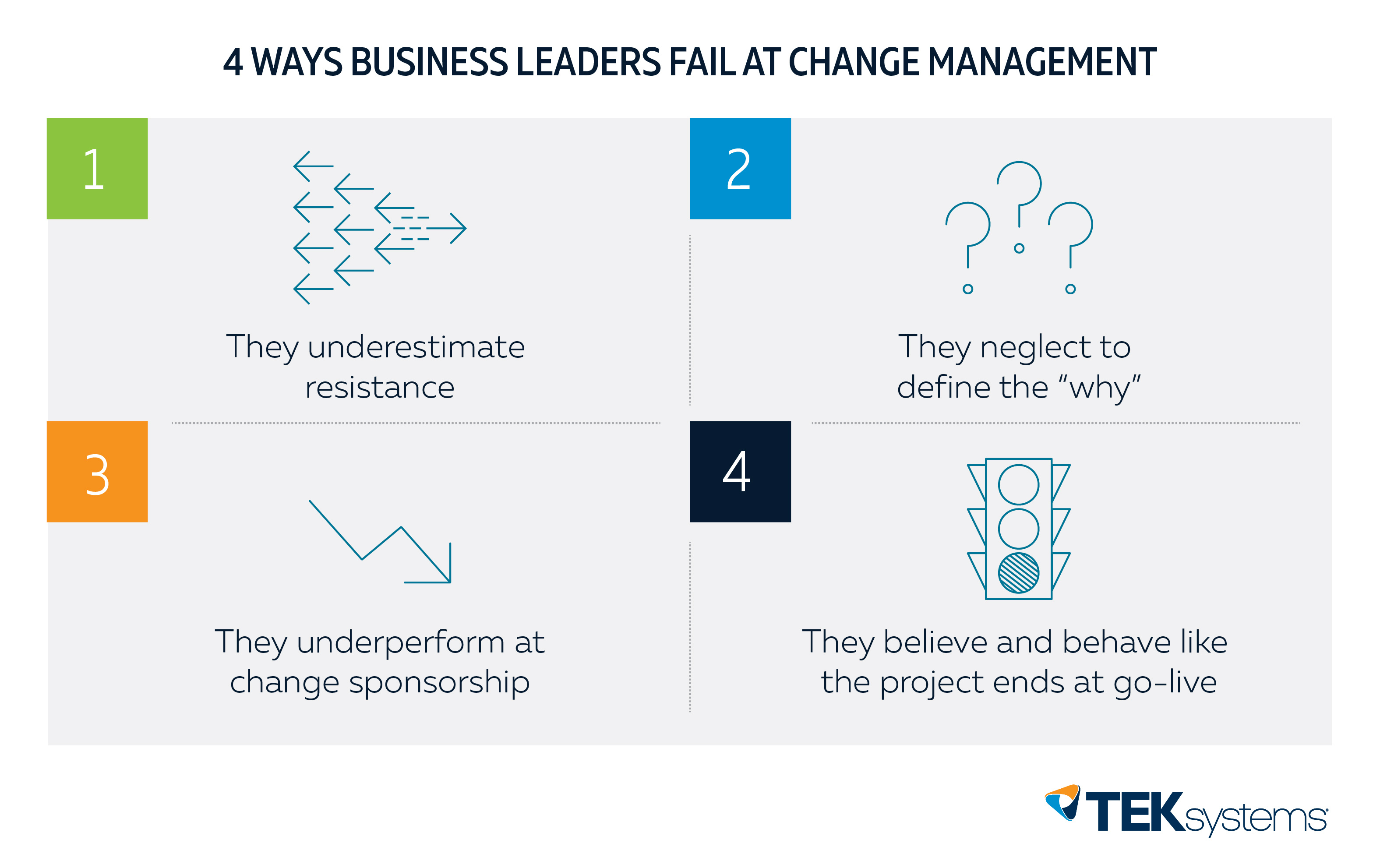4 ways business leaders fail at change management
(And how you can do better)
April 16, 2018 | By Scott Wieder

I once worked with a global manufacturer to institute a badly needed project management office. They’d tried three previous times and failed to successfully implement and sustain the PMO, each time squandering money, effort and goodwill. The fourth time, they got serious about change management.
In the era of rapid and constant change, I believe organizational change management (OCM) is one of the key competencies that will determine whether companies succeed or fail at meeting this challenge. Like it or not, change is the new norm. Unfortunately, I see companies failing in the same ways all too frequently, such as putting tools ahead of rules. It’s my hope that change leaders can learn from these mistakes and avoid them.
4 common change management mistakes leaders make
1. They underestimate resistance
Imagine you’re an individual contributor. You’ve figured out how to use the tools and processes to get your job done, and you’re busy with … well, work. One day you’re told you’re going to be using new tools and processes and that you’ll be responsible for attending training.
Your reaction is:
A) Great, I get to use new tools that will be great for the company! I totally don’t mind having to learn a bunch of new things on top of my already busy workload.
B) Ugh, I have to find time to learn a whole bunch of new things, and I’m not even sure they’re better than the old things.
C) Sure, I’ll give it a try but when I really need something, I can always work around the new process. I’ve been here long enough to know how things really happen.
From my experience, most workers feel some combination of B and C. For some people, these feelings run very deep, and those people can slow change adoption immensely, or even cause it to fail. In addition, the productivity dip that occurs during all transition states will incur a deeper trough and longer timeline, thus reducing your expected ROI.
The optimal time to mitigate change resistance is before it hardens—which is why the most successful OCM programs ideally start before a project kickoff with a robust stakeholder management and resistance approach. All stakeholder groups are different; you must care for the situational uniqueness of each group. This helps you (or your OCM partner) identify the root causes of the resistance and allows for a mitigation approach that includes feedback loops and metrics.
2. They neglect to define the ‘why’
If you’re undertaking a significant change like implementing a new technology platform or cloud migration—and all the process and behavior changes that accompany it—you sure better have a more persuasive and impactful “why” than “the technology is more modern” or “this is what our competitors are doing.” Everyone involved in the project needs to be aware of and understand the business drivers. In addition, you need to message your “why” in a way that people being impacted can understand and how they will benefit from the change. The cascading of this critical narrative and behavior must be consistent, visible and clear.
This may all sound obvious, but you’d be surprised how many times I’ve worked with organizations that hadn’t clearly defined the business reasons for instituting an expensive and disruptive change that impacted multiple stakeholder groups. Or the times each sponsor had his or her own reason for going forward, making it nearly impossible to define measurable and consistent goals when they got down to the brass tacks of implementation and sustainment.
Defining and aligning around why you’re making a change is the first step to bringing end users along with your vision. If you can clearly articulate the tangible benefits that will accrue to your company and the people impacted, you’ll mitigate a significant portion of the organizational resistance.
3. They underperform at change sponsorship
The most critical success factor for change adoption is active, visible and committed sponsorship. That means you have a lot of work to do on a daily basis to ensure change success. Change requires commitment from the top levels of leadership down to individual contributors.
OCM sponsor roles
- Executive sponsor: Generally a senior leader who funds the project, this role owns the high-level messaging around why a project is important to business success.
- Sustaining sponsor: Often a director—from either the business or IT side—who touches the project on a daily basis, this person reinforces the narrative of why the change matters and models the desired behaviors.
- Line-level sponsors: Your end users mimic the behaviors of their leaders, so your first-line supervisors need to champion the change and model the behaviors of the change on a daily basis. This role needs support, including change coaching, mentoring and training in how to use and message the new tools and processes. In addition, the messaging from these leaders must include two things for change success: a reward and a consequence. Compliance doesn’t drive change, commitment does!
4. They believe and behave like the project ends at go-live
Sustainable and measurable change can be time-consuming to implement, and the culture component from major investments generally takes 18-36 months to be fully realized and measurable. Unfortunately, most companies lack the commitment and capability to continue the change program after go-live. The value of OCM has a strong pre go-live component, but the significant and lasting value is attained after go-live. The reinforcement and sustainment activities must be cared for with the same level of vigor as during the implementation period to ensure adoption rates align to ROI requirements—and actually stick. The lack of sustainment and ongoing optimization mostly stems from an absence of clear ownership. Think about how a project manager leading an implementation is graded: on the time, cost and quality of installation of new software up to the go-live date. And then that person moves on the next project, leaving a void in caring for the sustainment of the change. This void must be addressed in the change approach and implemented 30-60 days before go-live to ensure an effective transition.
This is where building a network of change agents and champions can add significant value and change agility. These people help ensure adoption rates are met and sustained after the project team has moved on. Look for early adopters and people who like living near the tip of the spear and who can encourage others to embrace change while modeling the appropriate behaviors. You can sometimes find these key assets during your stakeholder analysis process, or you can partner with managers to identify and nominate them to perform this critical role. This can’t be a night job on top of their daily responsibilities. Commitment of time and energy must be clearly articulated and adhered to for this role to be effective in the long-term.

Why you need to improve your change capabilities
You’ve probably figured out that getting OCM right is expensive—in cost and time. But getting it wrong is a lot more expensive. It’s organizationally disruptive from not only a financial perspective but also a cultural one. Getting it wrong imperils trust in leadership, employee productivity and your employees’ personal commitment.
Scott Wieder is an Organizational Change Management (OCM) Practice Architect for TEKsystems Enterprise Service Management Practice. Scott has spent the past 28 years providing OCM Advisory Services and Implementation Services that cover the entire OCM life-cycle for 500 companies. He resides in North Plainfield, New Jersey.